SMART Indicator Report: NE Shelf Functional Trait Indicators
2 Indicator name
NE Shelf Functional Trait Indicators
Includes variable(s): FALL-age_maturity, FALL-fecundity, FALL-k, FALL-l_inf, FALL-length_maturity, FALL-max_obs_length, FALL-offspring_size, FALL-PC1, FALL-PC2, FALL-PC3, FALL-trophic_level, SPRING-age_maturity, SPRING-fecundity, SPRING-k, SPRING-l_inf, SPRING-length_maturity, SPRING-max_obs_length, SPRING-offspring_size, SPRING-PC1, SPRING-PC2, SPRING-PC3, SPRING-trophic_level
3 Indicator brief description
These data represent estimates of trait distributions for key functional traits amongst finfish species at each EPU on the Northeast Continental Shelf.
4 Indicator visualization
SOE_Submission_results.docx I’m happy to share the code used to produce these figures from the data linked above.
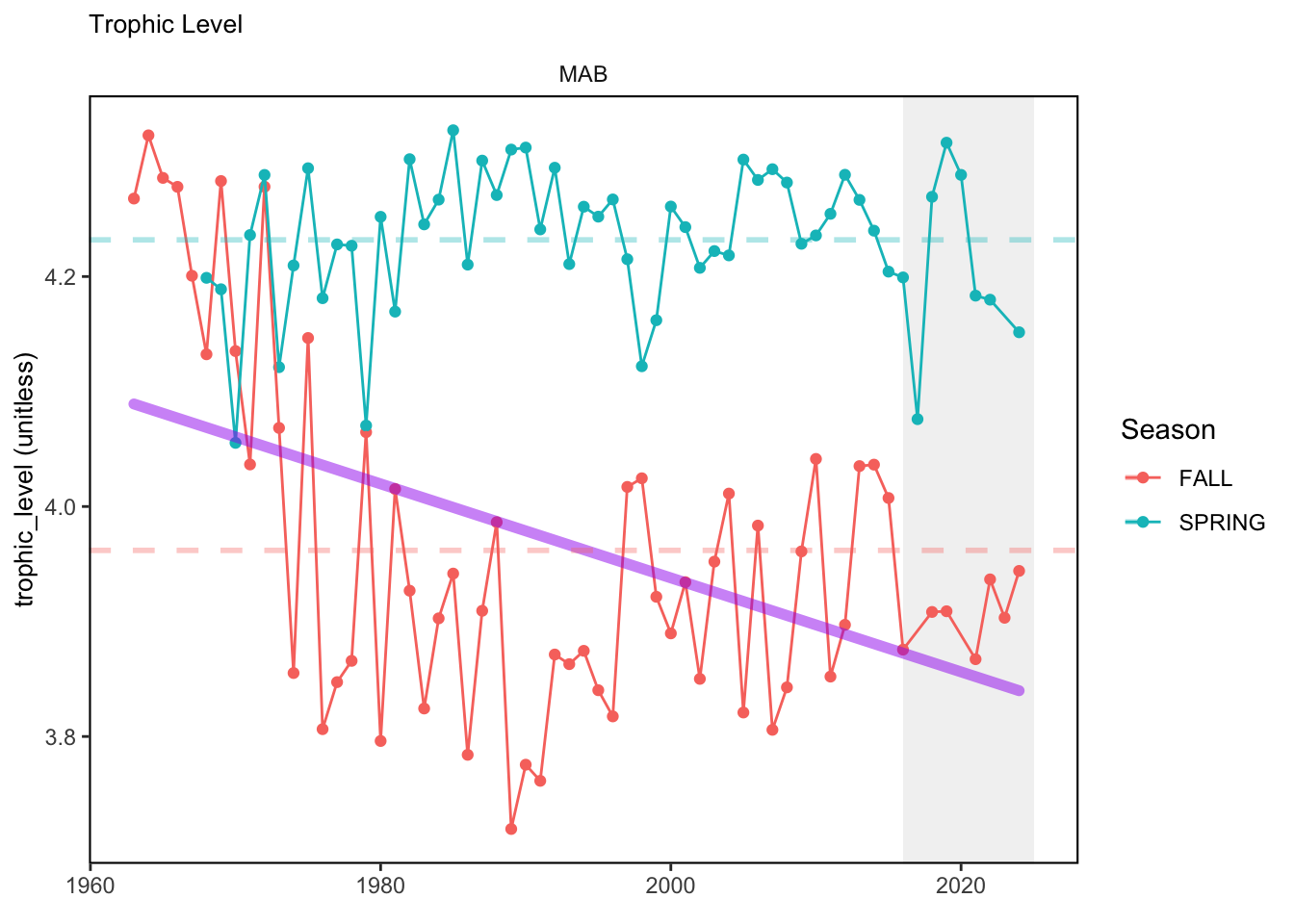
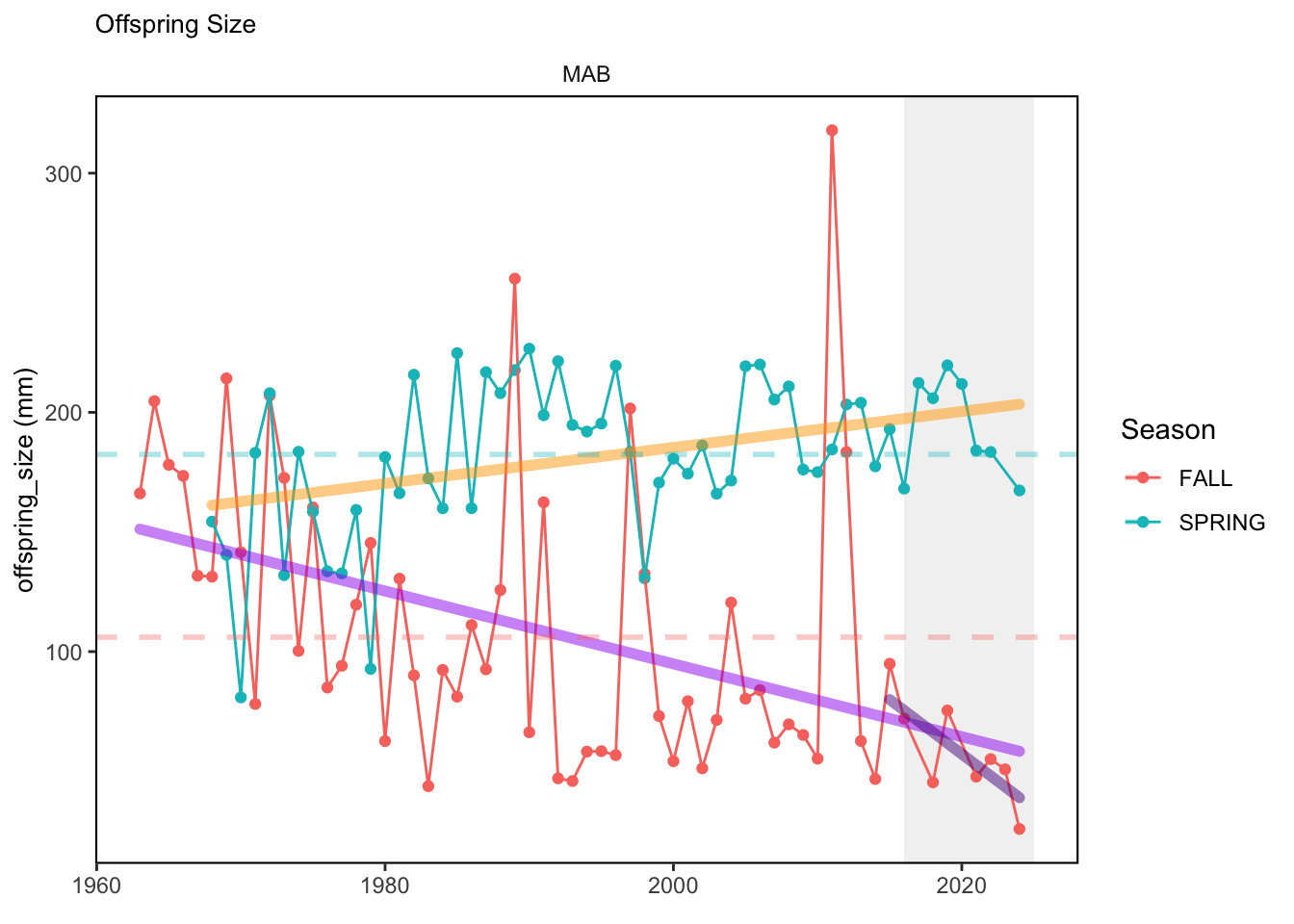
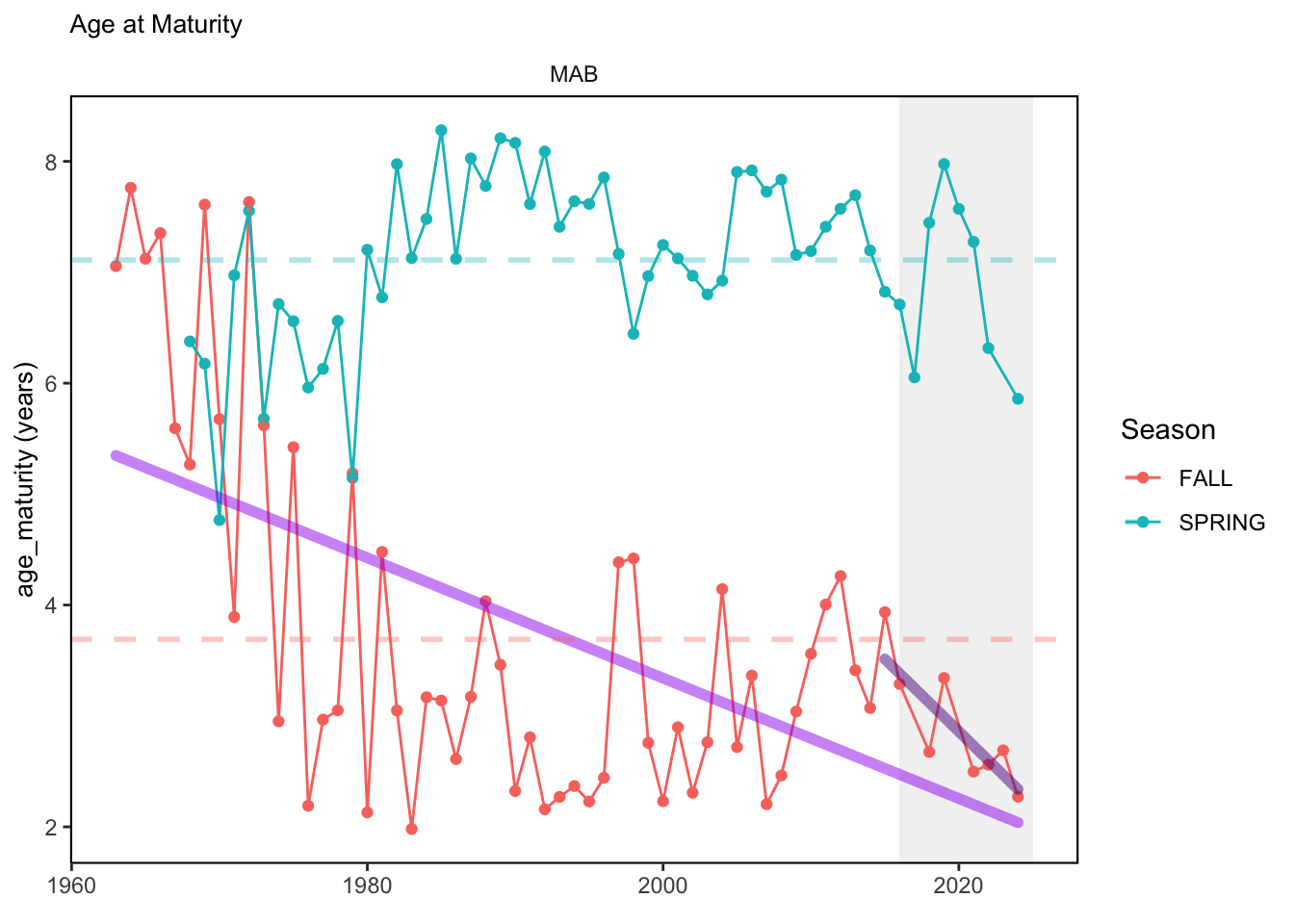

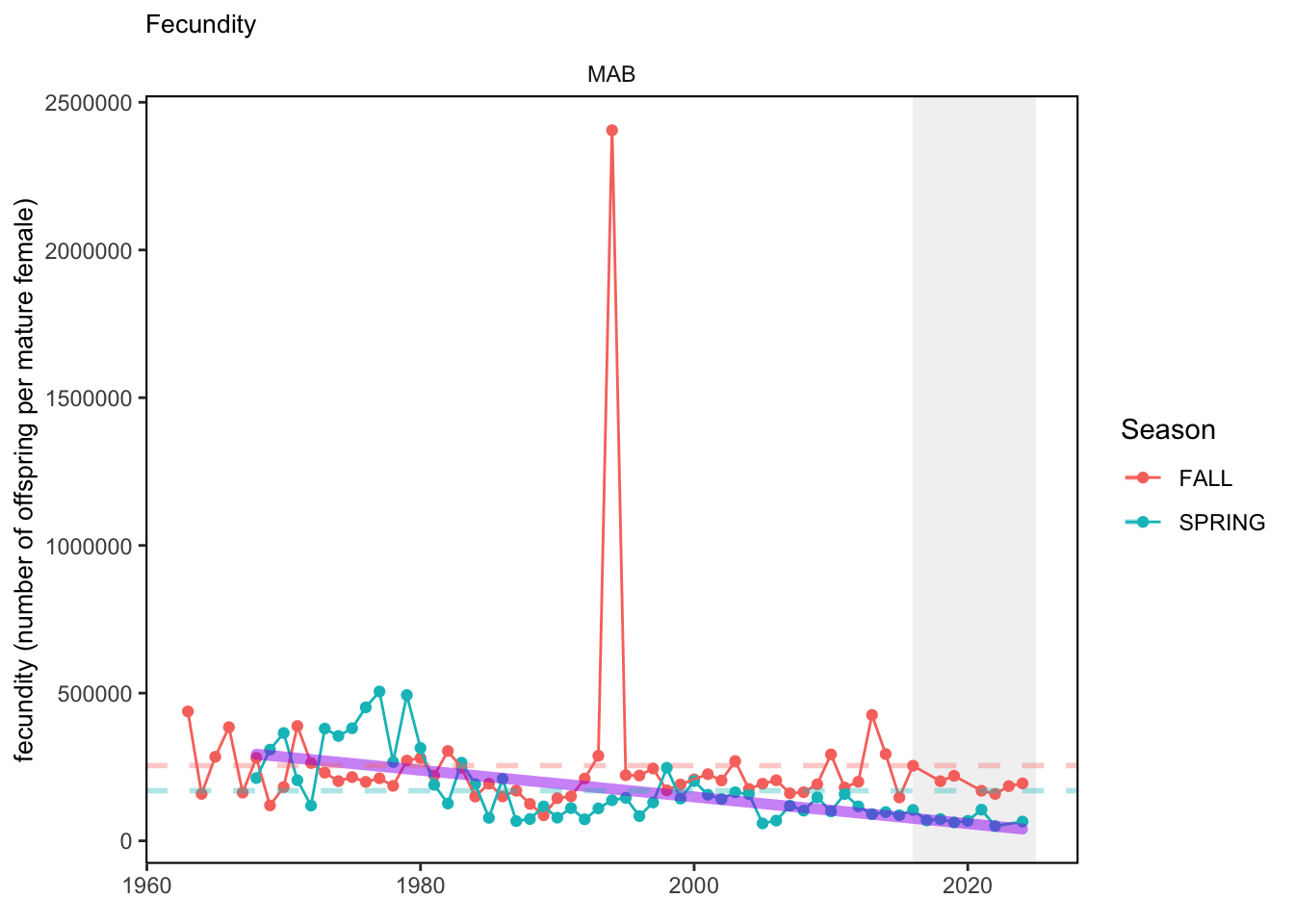
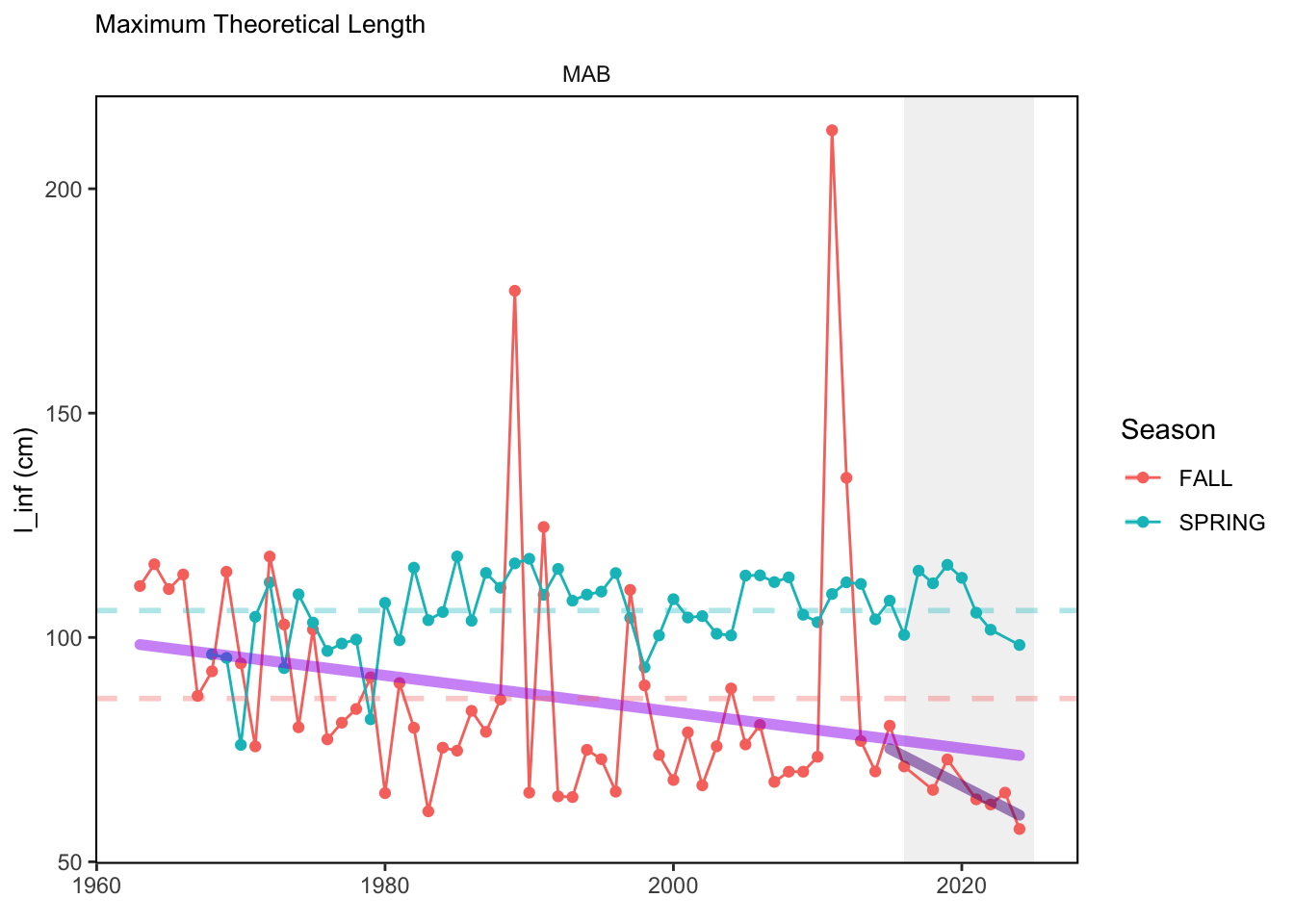
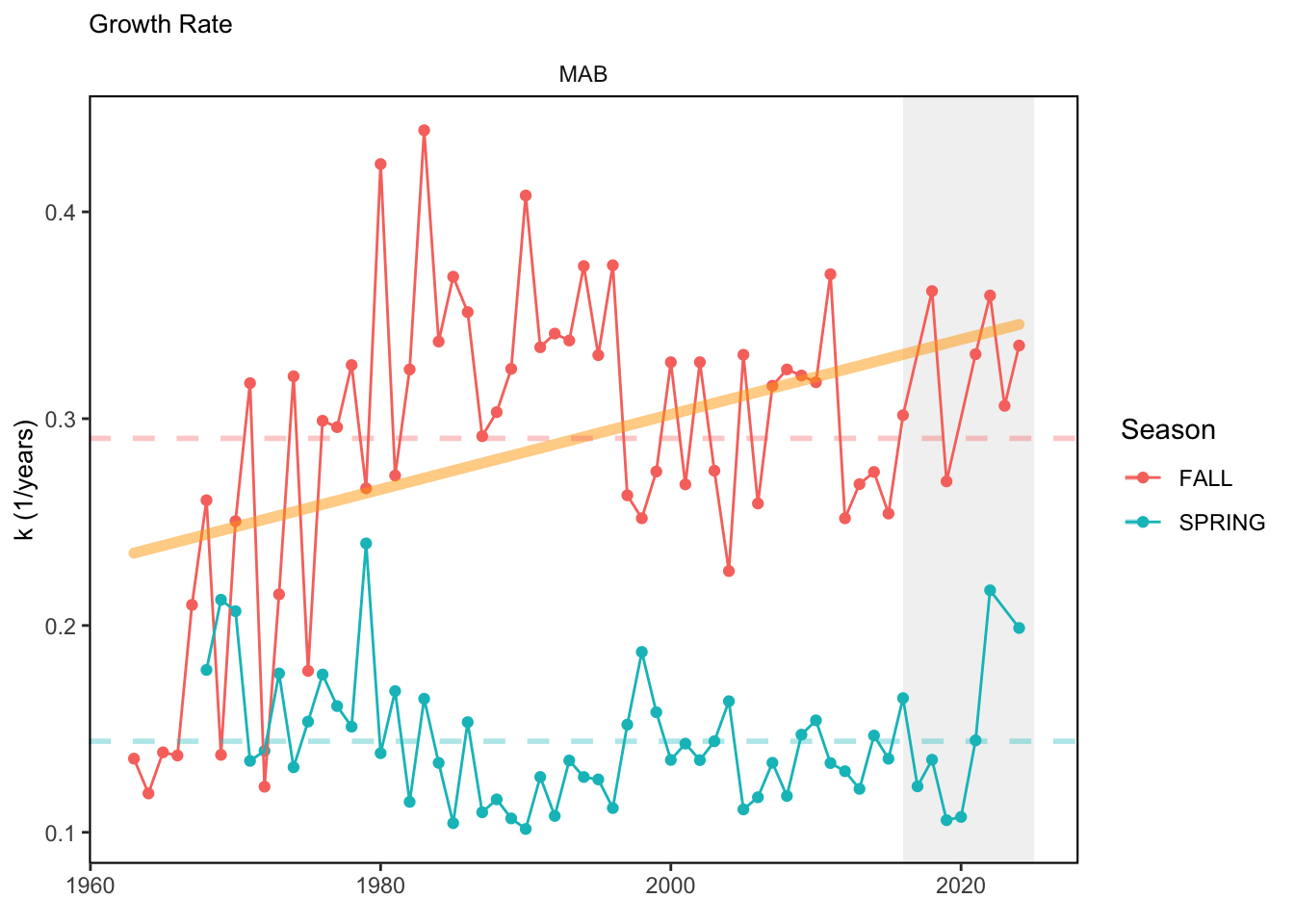


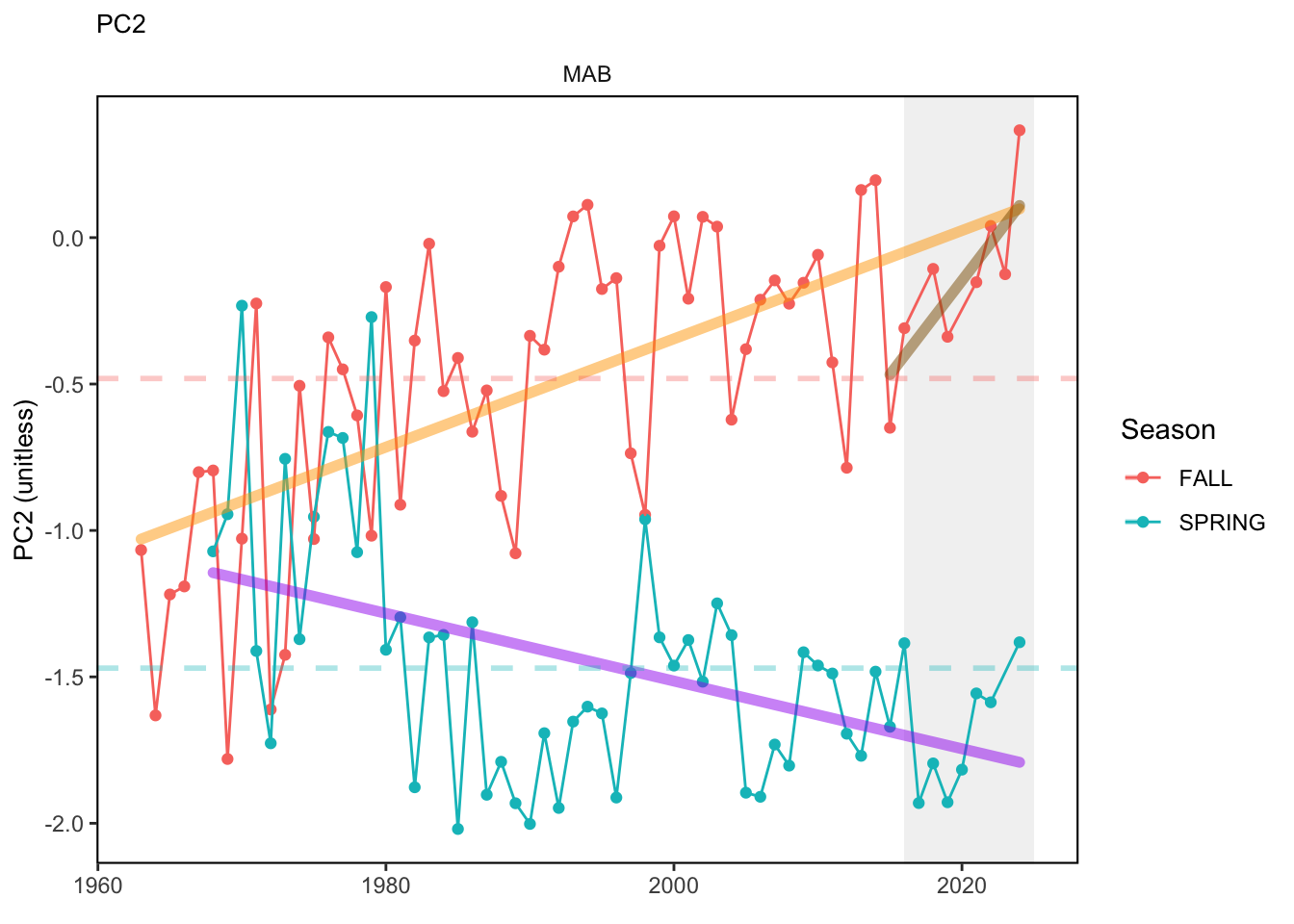
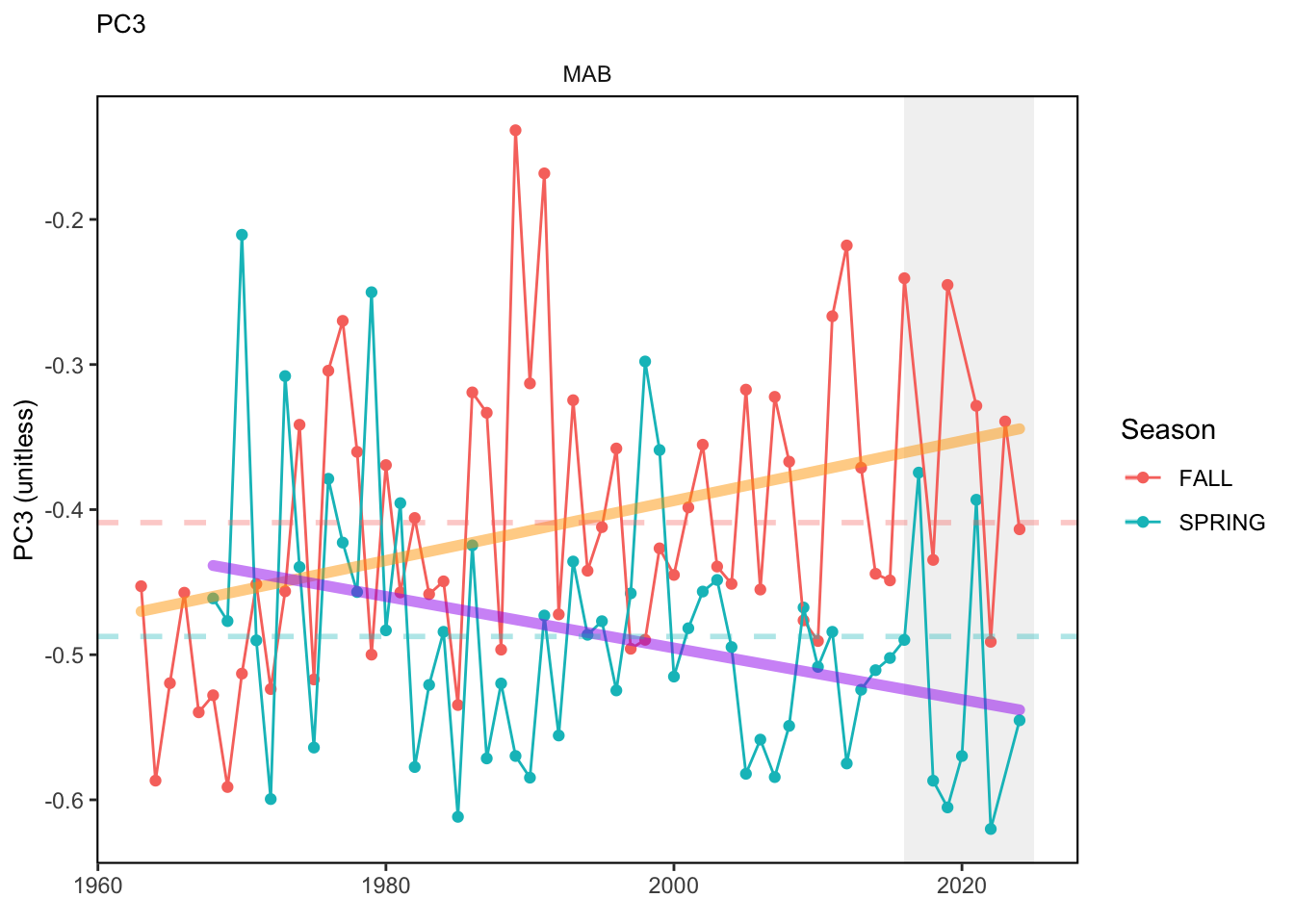
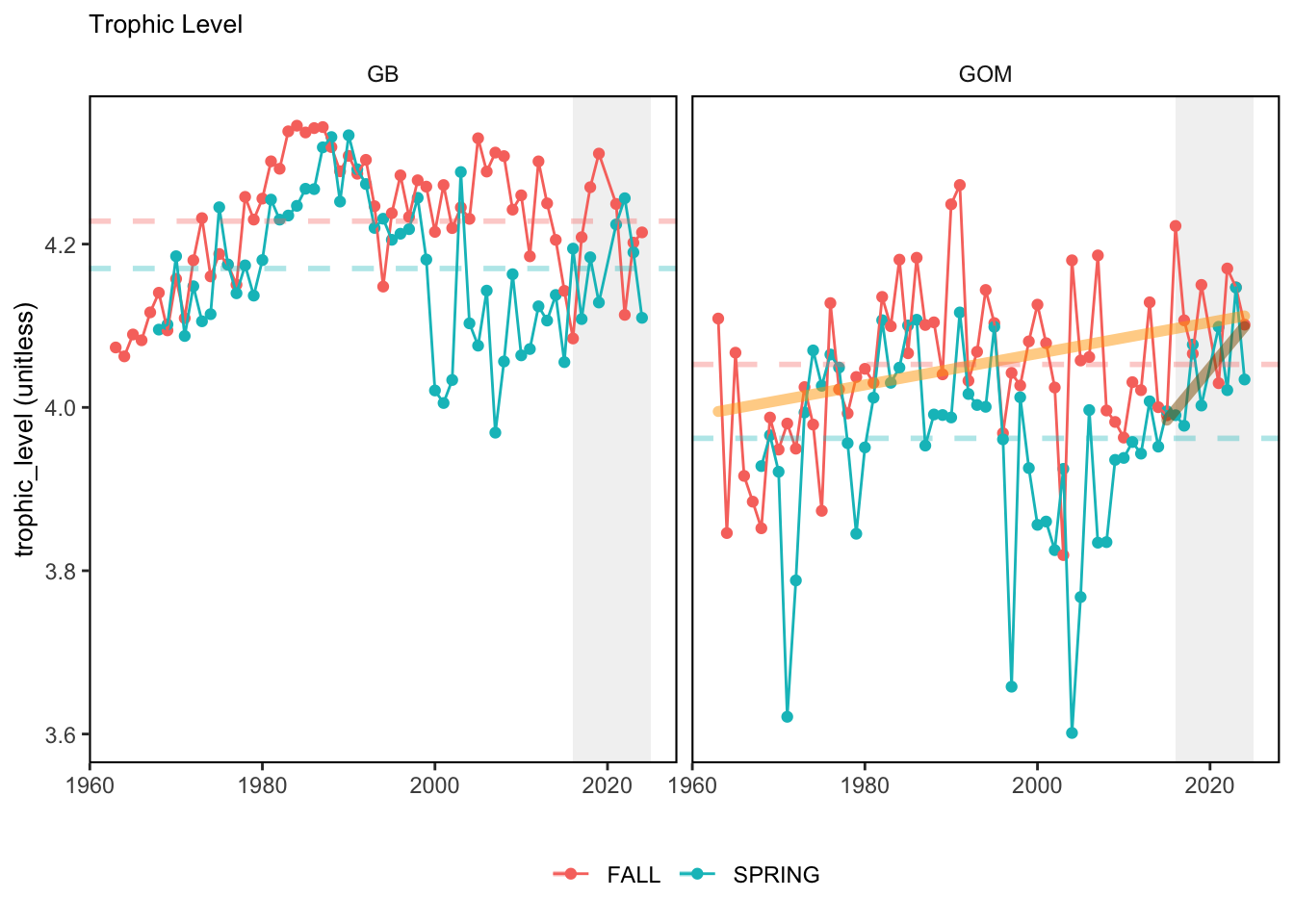
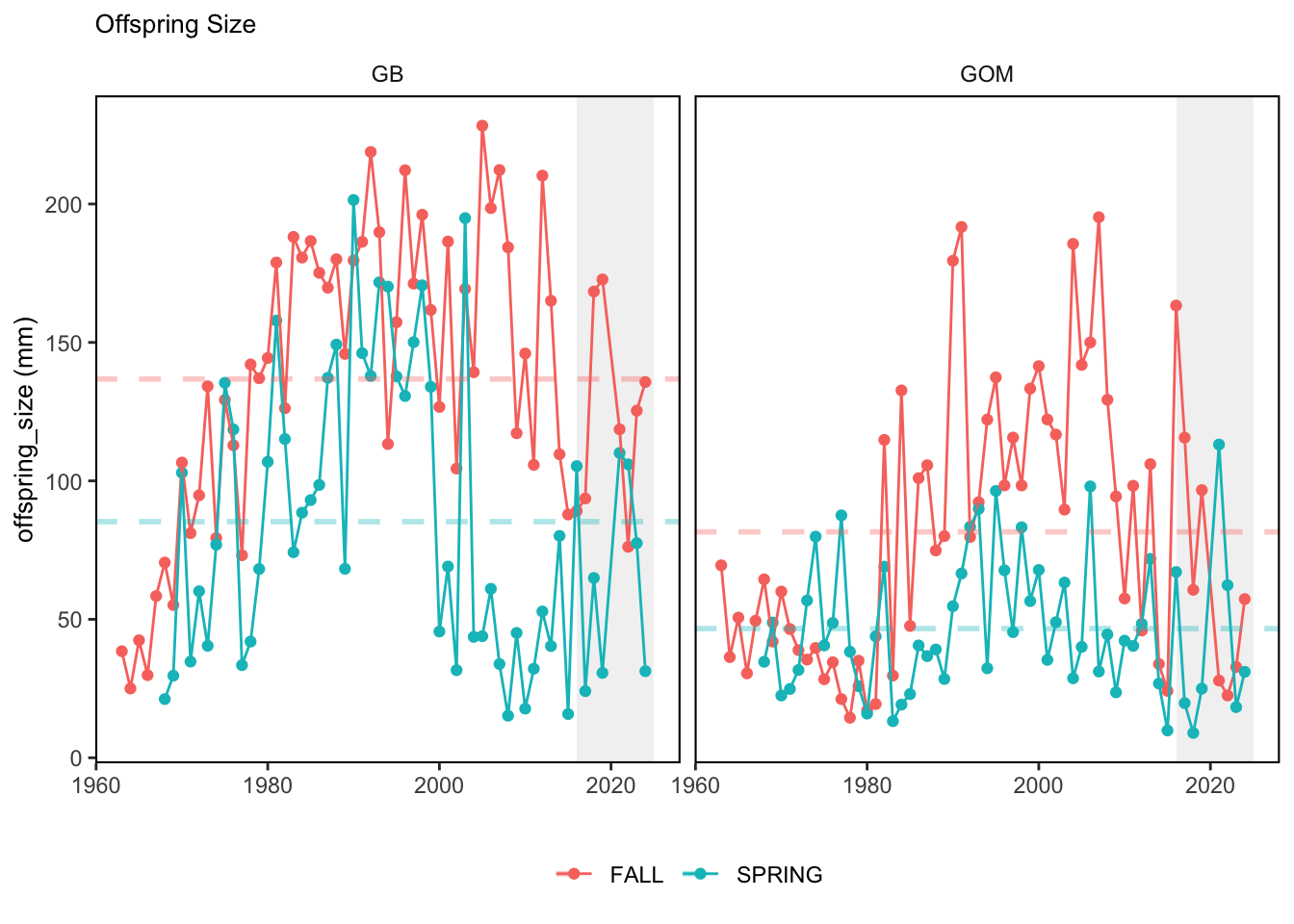
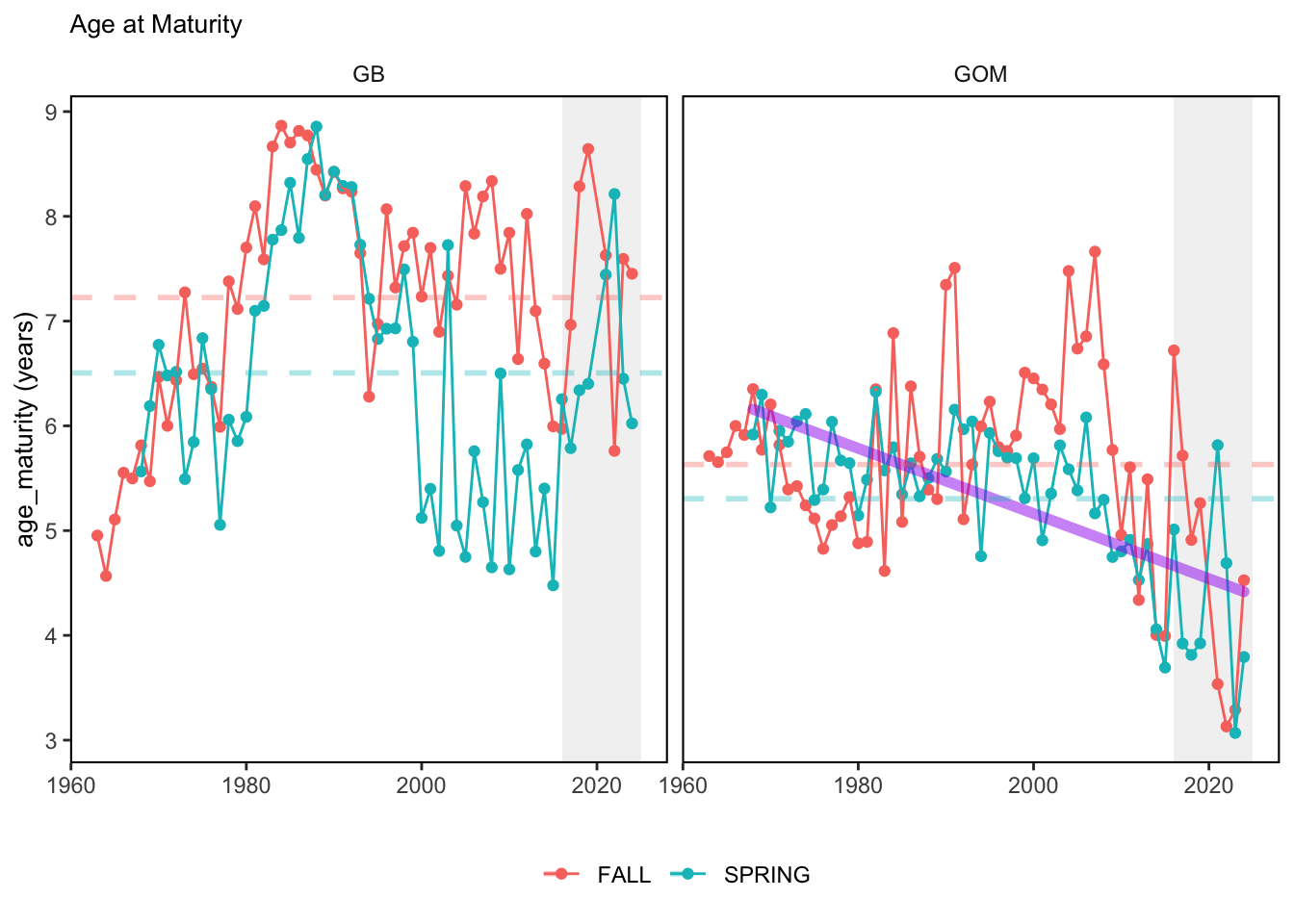
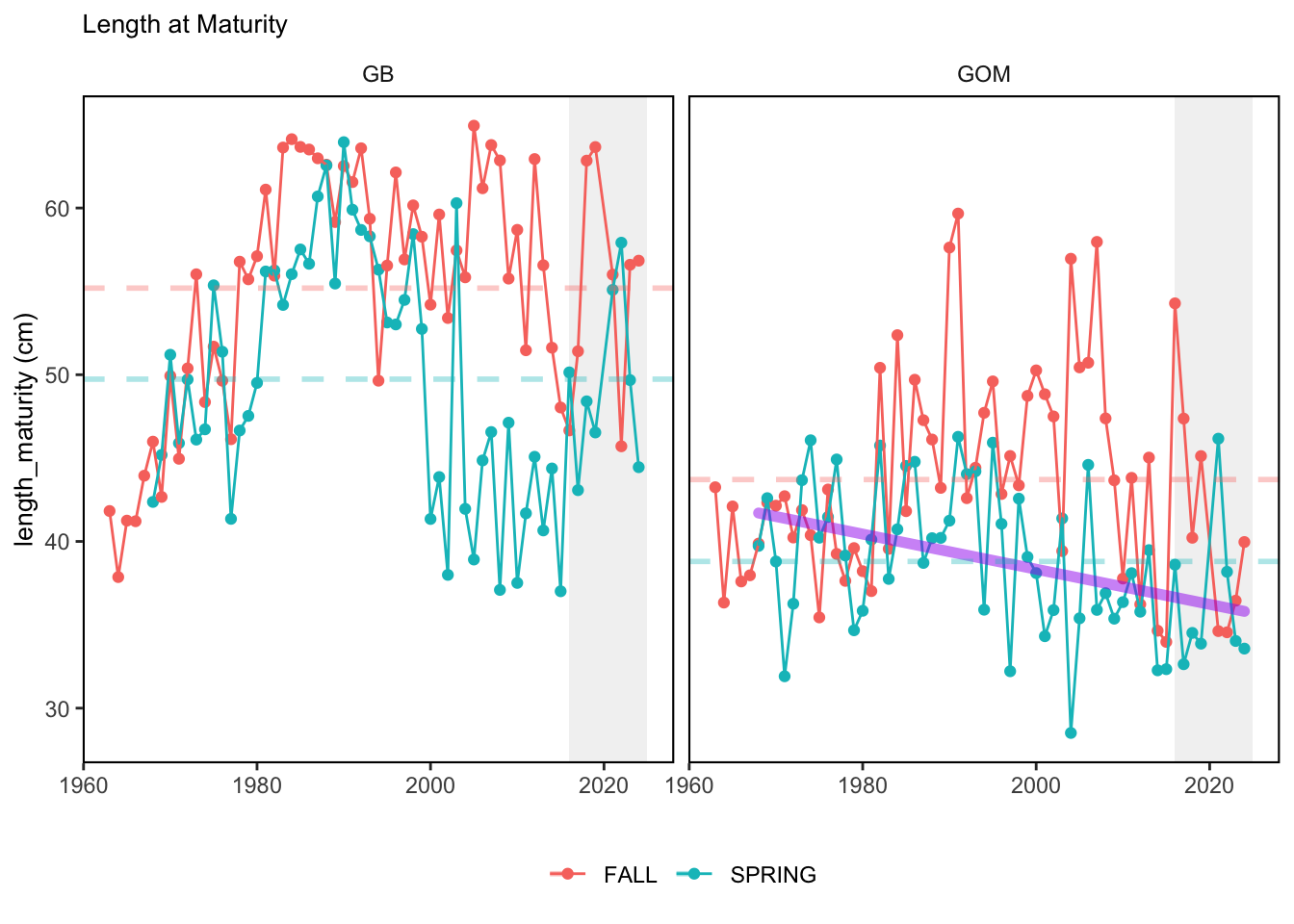
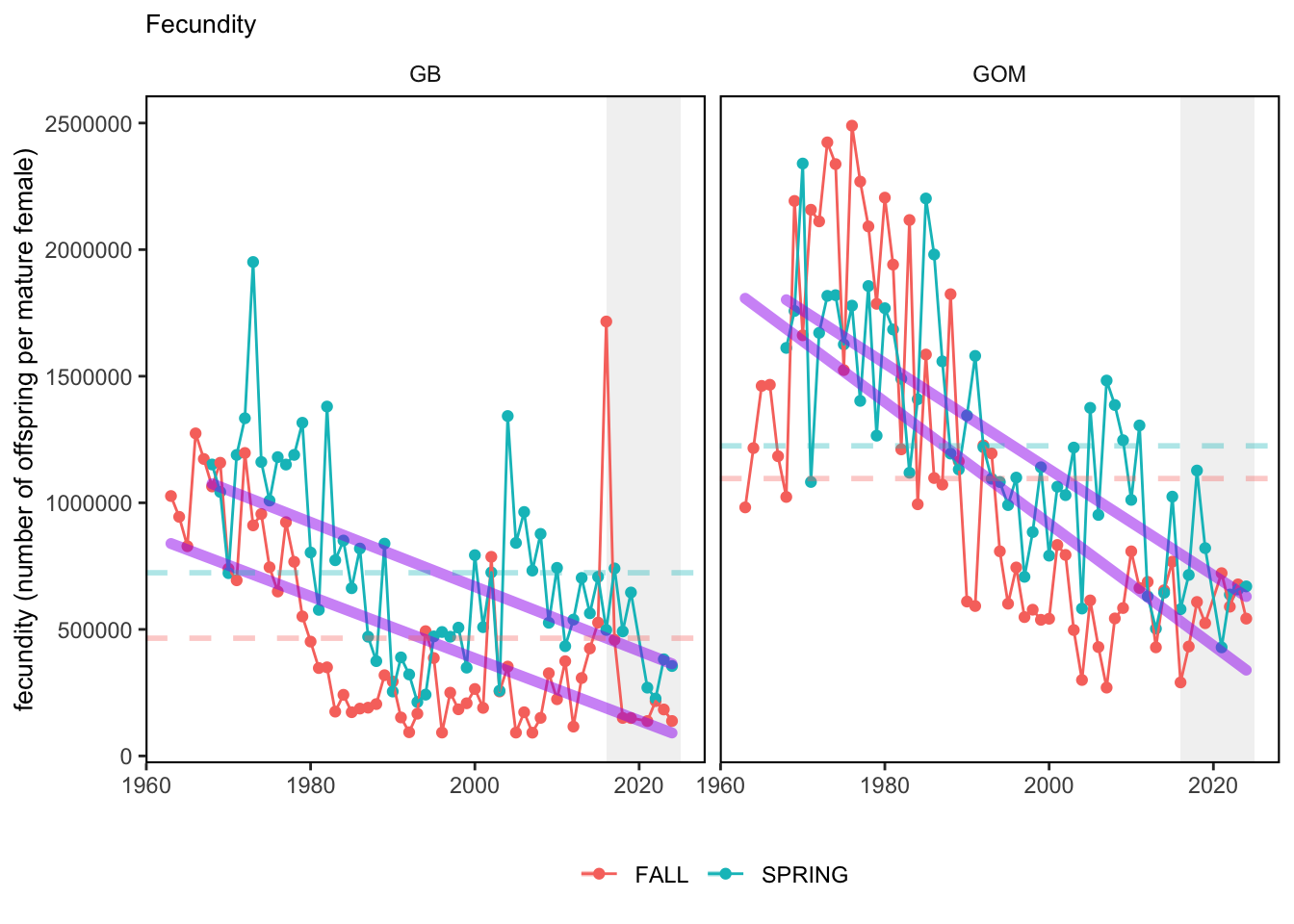
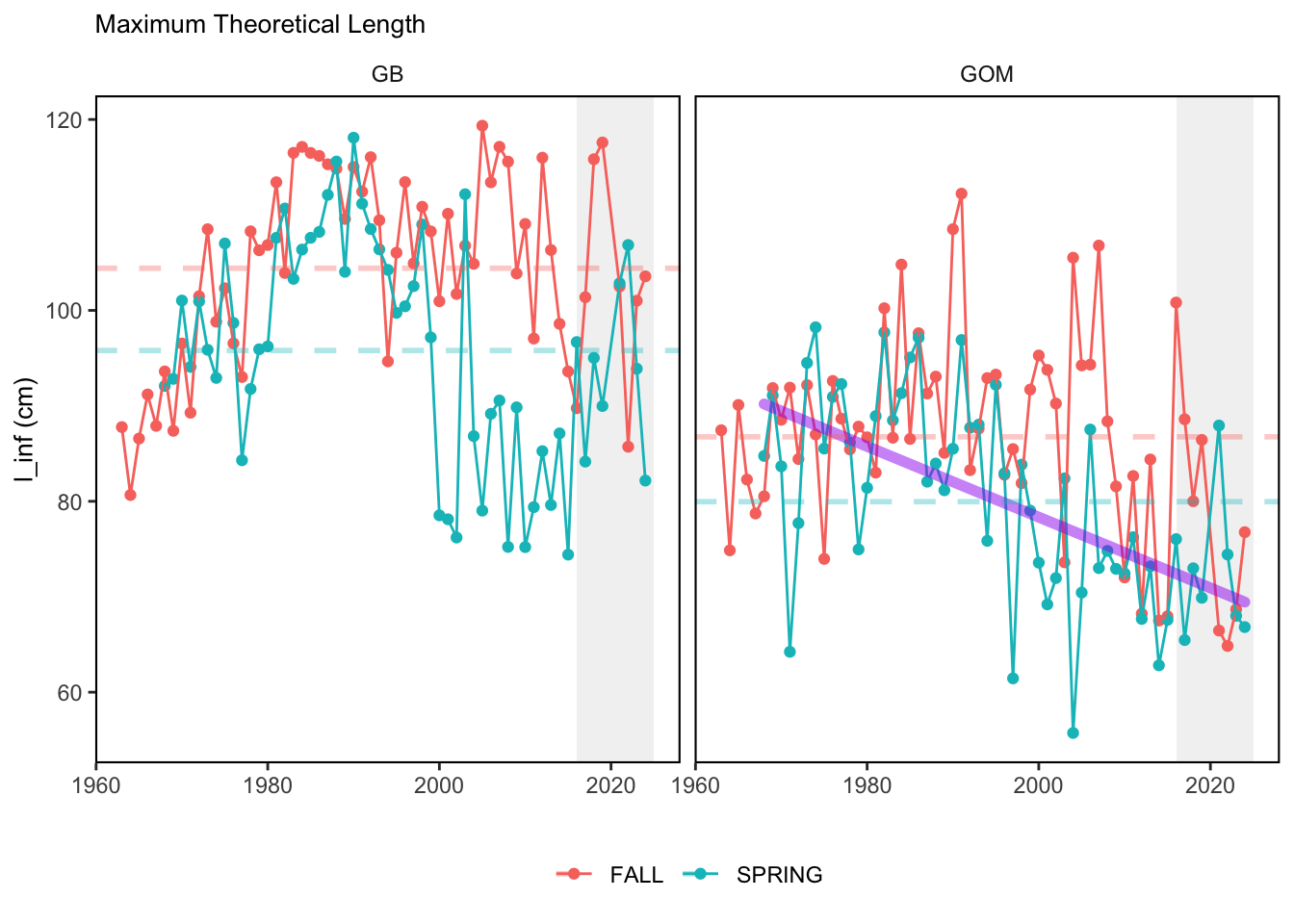
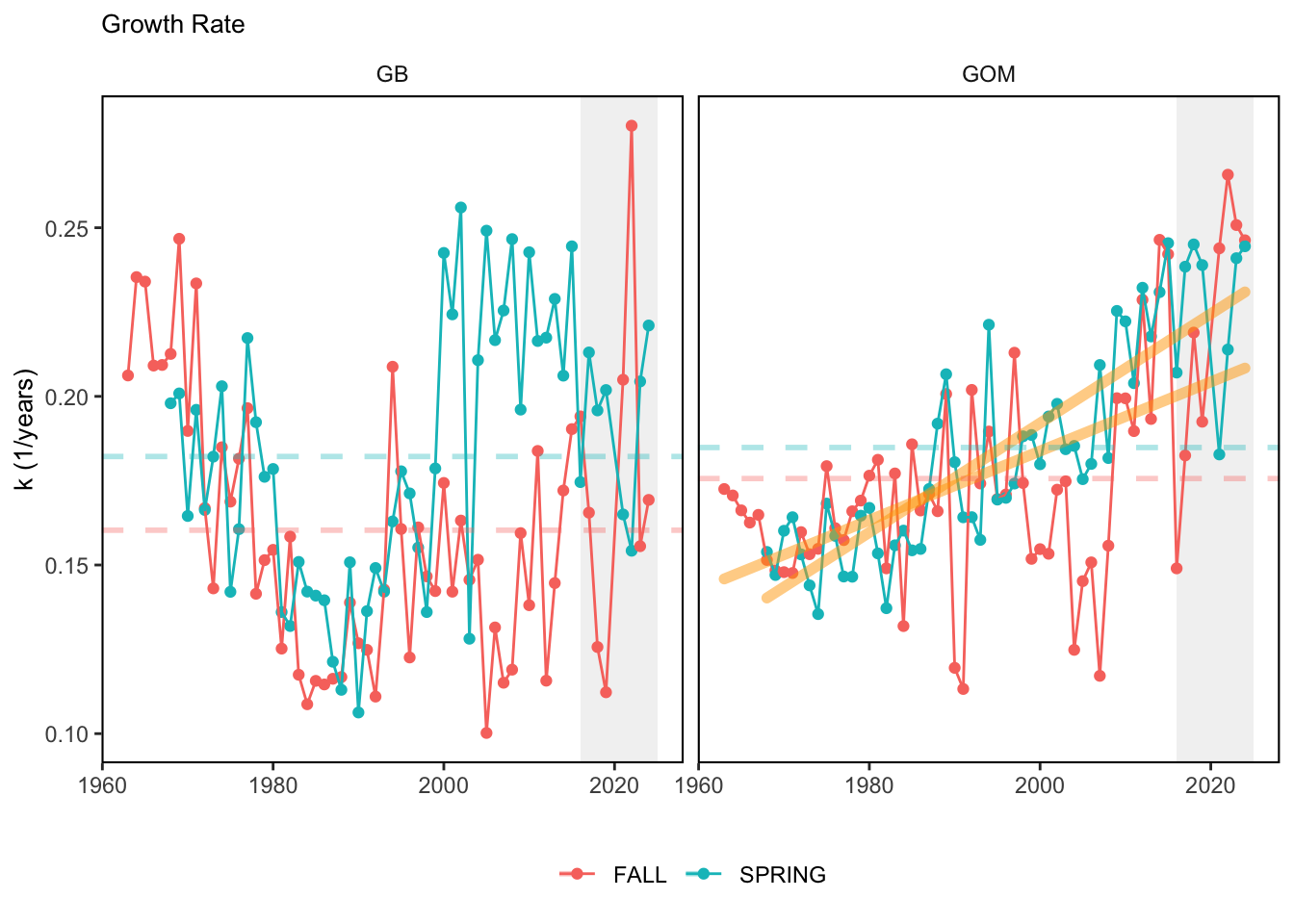
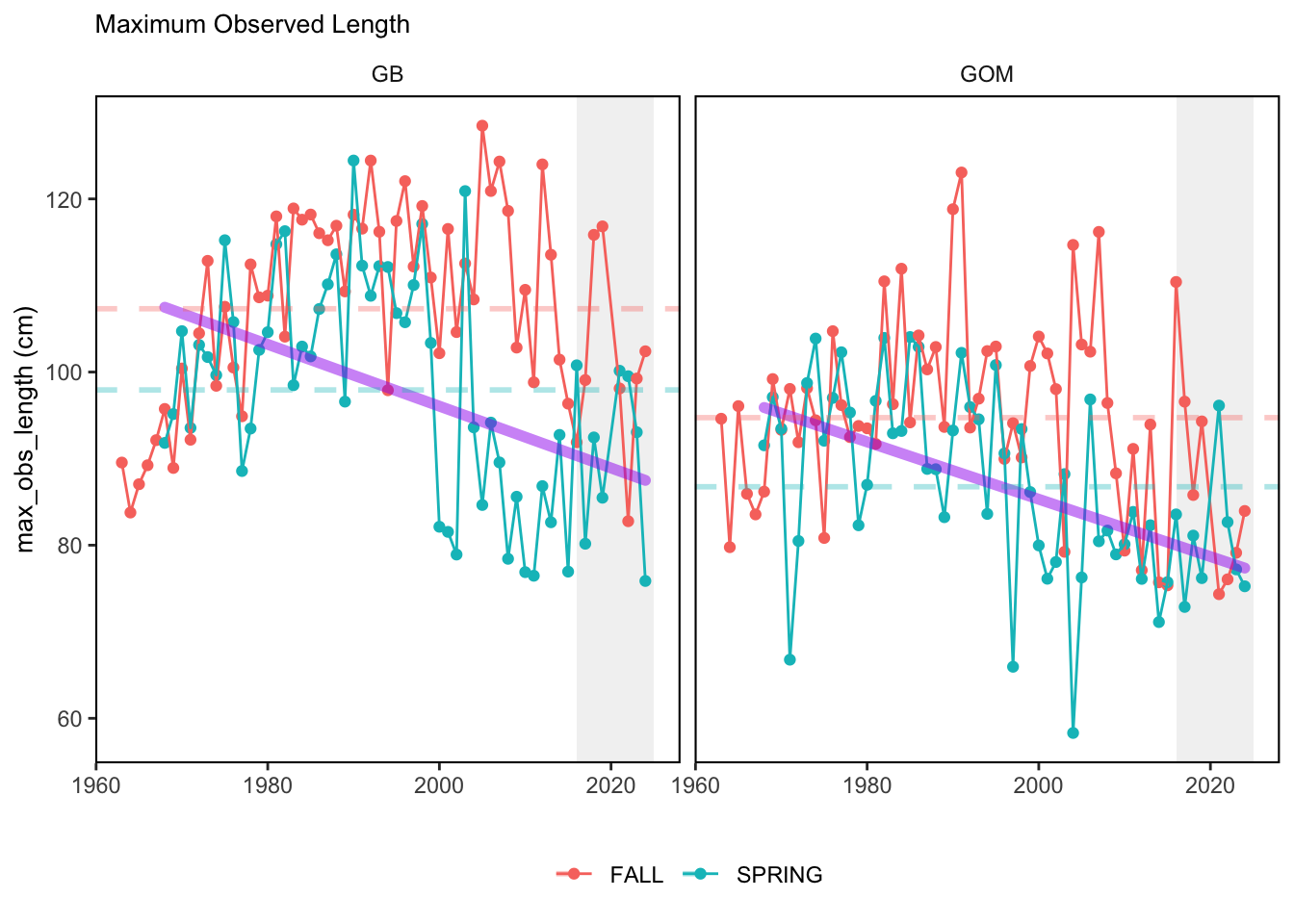
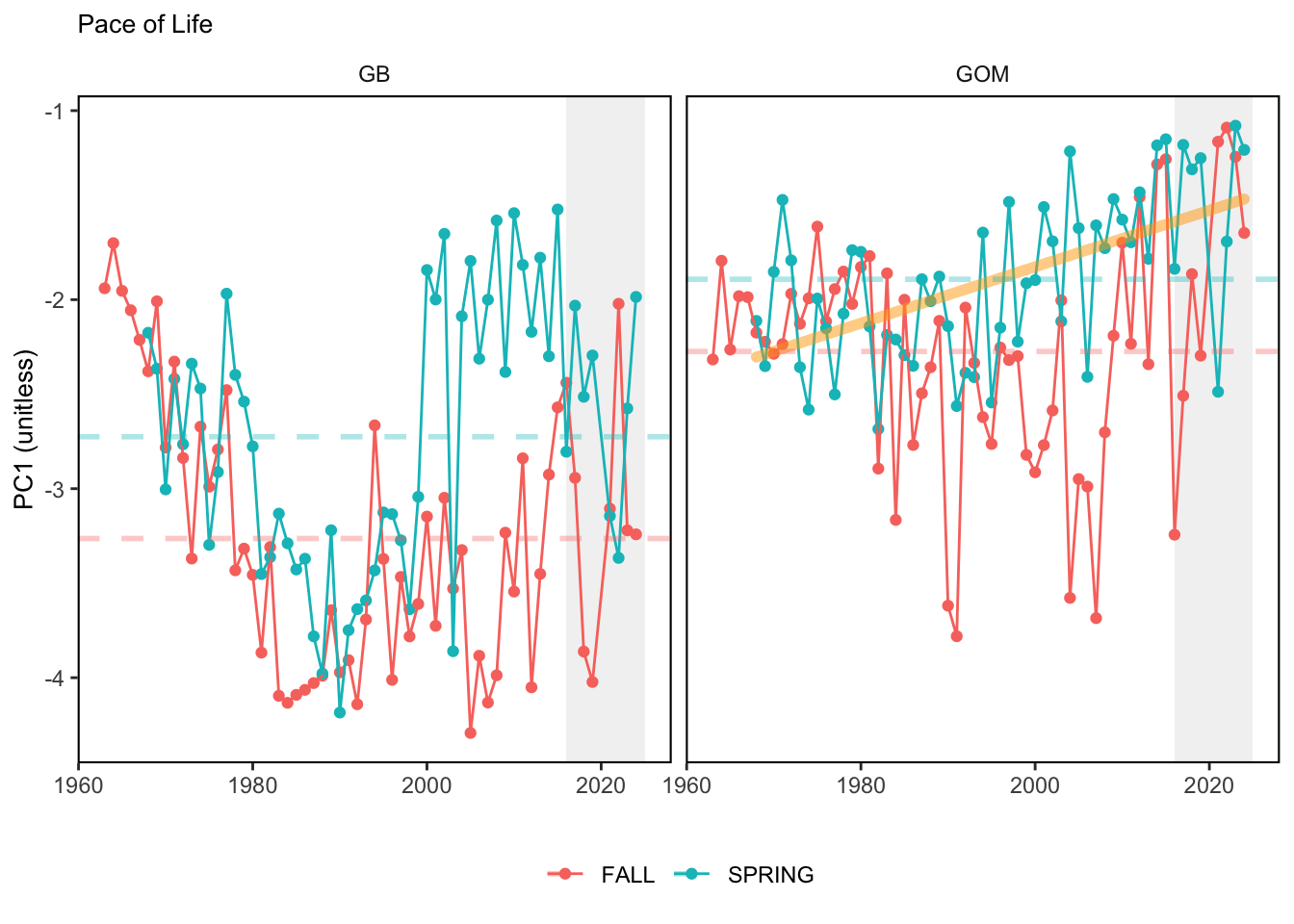
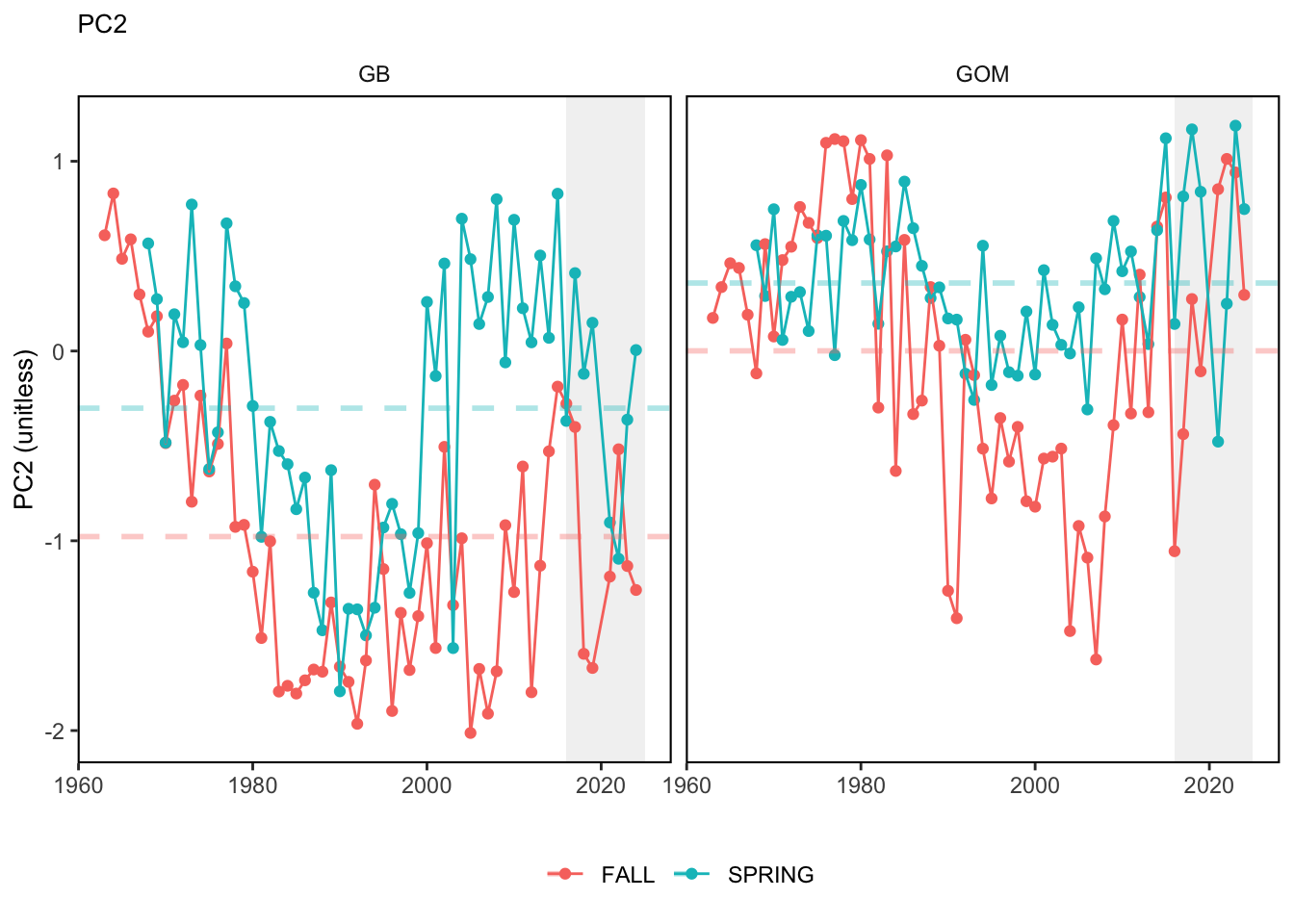
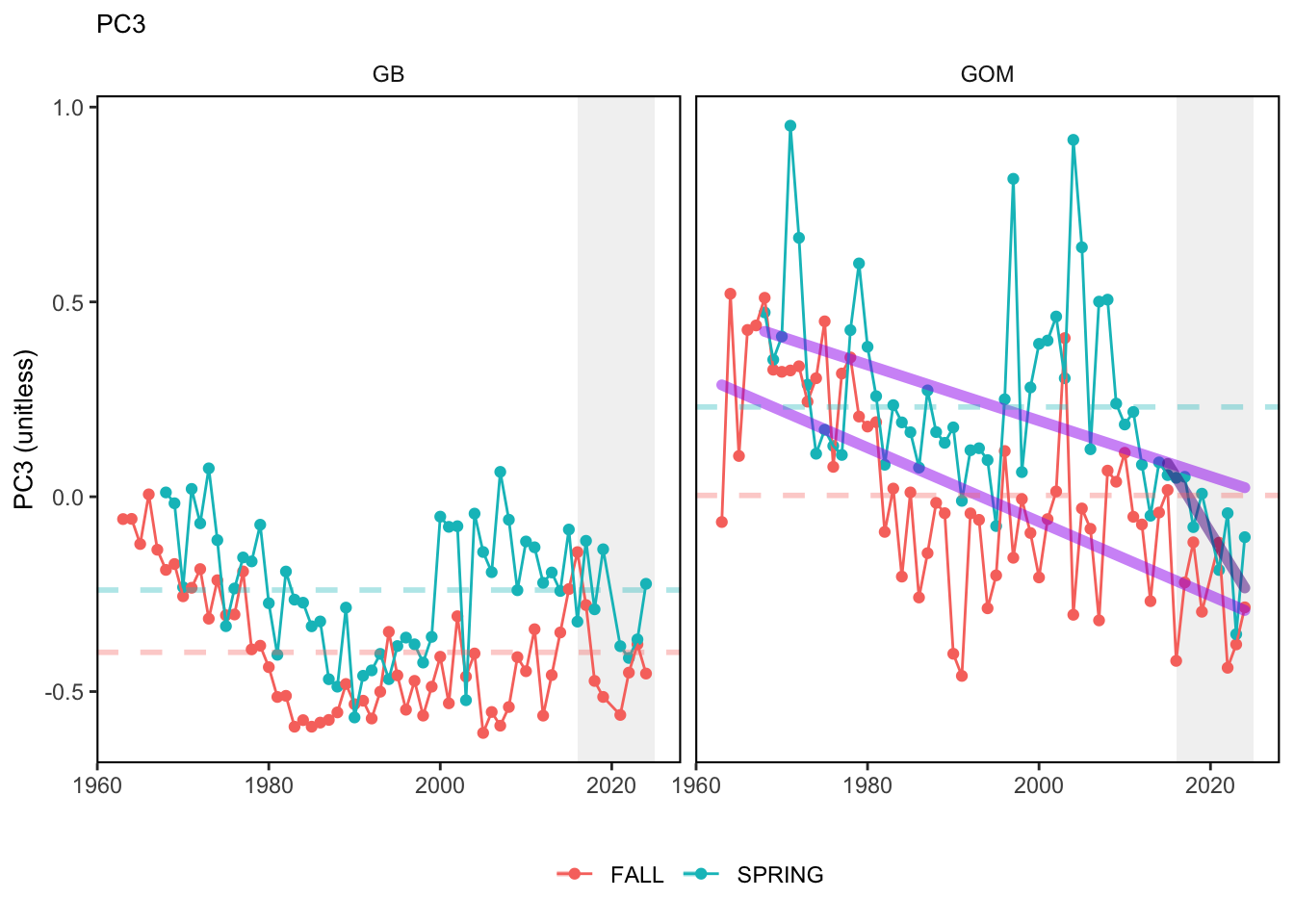
5 Indicator documentation
5.1 Are indicators available for others to use (data downloadable)?
## Yes5.1.1 Where can indicators be found?
## Data: https://noaa-edab.github.io/ecodata/index.html
## Description: https://noaa-edab.github.io/catalog/finfish_traits.html
## Technical documentation: https://noaa-edab.github.io/tech-doc/finfish_traits.html5.1.2 How often are they updated? Are future updates likely?
[need sequential look at datasets for update frequency. Future requires judgement]
5.1.3 Who is the contact?
Bart DiFiore (bdifiore@gmri.org)
5.2 Gather indicator statistics
5.2.1 Units
Indicator | Units |
|---|---|
FALL-age_maturity | years |
FALL-fecundity | number of offspring per mature female |
FALL-k | 1/years |
FALL-l_inf | cm |
FALL-length_maturity | cm |
FALL-max_obs_length | cm |
FALL-offspring_size | mm |
FALL-PC1 | unitless |
FALL-PC2 | unitless |
FALL-PC3 | unitless |
FALL-trophic_level | unitless |
SPRING-age_maturity | years |
SPRING-fecundity | number of offspring per mature female |
SPRING-k | 1/years |
SPRING-l_inf | cm |
SPRING-length_maturity | cm |
SPRING-max_obs_length | cm |
SPRING-offspring_size | mm |
SPRING-PC1 | unitless |
SPRING-PC2 | unitless |
SPRING-PC3 | unitless |
SPRING-trophic_level | unitless |
5.2.2 Length of time series, start and end date, periodicity
General overview: 1963-2023, Spring (January-June) & Fall (July-December)
Indicator specifics:
Indicator | EPU | StartYear | EndYear | NumYears | MissingYears |
|---|---|---|---|---|---|
FALL-age_maturity | GB | 1963 | 2024 | 61 | 1 |
FALL-age_maturity | GOM | 1963 | 2024 | 61 | 1 |
FALL-age_maturity | MAB | 1963 | 2024 | 60 | 2 |
FALL-age_maturity | NEshelf | 1963 | 2024 | 61 | 1 |
FALL-age_maturity | SS | 1963 | 2024 | 61 | 1 |
FALL-fecundity | GB | 1963 | 2024 | 61 | 1 |
FALL-fecundity | GOM | 1963 | 2024 | 61 | 1 |
FALL-fecundity | MAB | 1963 | 2024 | 60 | 2 |
FALL-fecundity | NEshelf | 1963 | 2024 | 61 | 1 |
FALL-fecundity | SS | 1963 | 2024 | 61 | 1 |
FALL-k | GB | 1963 | 2024 | 61 | 1 |
FALL-k | GOM | 1963 | 2024 | 61 | 1 |
FALL-k | MAB | 1963 | 2024 | 60 | 2 |
FALL-k | NEshelf | 1963 | 2024 | 61 | 1 |
FALL-k | SS | 1963 | 2024 | 61 | 1 |
FALL-l_inf | GB | 1963 | 2024 | 61 | 1 |
FALL-l_inf | GOM | 1963 | 2024 | 61 | 1 |
FALL-l_inf | MAB | 1963 | 2024 | 60 | 2 |
FALL-l_inf | NEshelf | 1963 | 2024 | 61 | 1 |
FALL-l_inf | SS | 1963 | 2024 | 61 | 1 |
FALL-length_maturity | GB | 1963 | 2024 | 61 | 1 |
FALL-length_maturity | GOM | 1963 | 2024 | 61 | 1 |
FALL-length_maturity | MAB | 1963 | 2024 | 60 | 2 |
FALL-length_maturity | NEshelf | 1963 | 2024 | 61 | 1 |
FALL-length_maturity | SS | 1963 | 2024 | 61 | 1 |
FALL-max_obs_length | GB | 1963 | 2024 | 61 | 1 |
FALL-max_obs_length | GOM | 1963 | 2024 | 61 | 1 |
FALL-max_obs_length | MAB | 1963 | 2024 | 60 | 2 |
FALL-max_obs_length | NEshelf | 1963 | 2024 | 61 | 1 |
FALL-max_obs_length | SS | 1963 | 2024 | 61 | 1 |
FALL-offspring_size | GB | 1963 | 2024 | 61 | 1 |
FALL-offspring_size | GOM | 1963 | 2024 | 61 | 1 |
FALL-offspring_size | MAB | 1963 | 2024 | 60 | 2 |
FALL-offspring_size | NEshelf | 1963 | 2024 | 61 | 1 |
FALL-offspring_size | SS | 1963 | 2024 | 61 | 1 |
FALL-PC1 | GB | 1963 | 2024 | 61 | 1 |
FALL-PC1 | GOM | 1963 | 2024 | 61 | 1 |
FALL-PC1 | MAB | 1963 | 2024 | 60 | 2 |
FALL-PC1 | NEshelf | 1963 | 2024 | 61 | 1 |
FALL-PC1 | SS | 1963 | 2024 | 61 | 1 |
FALL-PC2 | GB | 1963 | 2024 | 61 | 1 |
FALL-PC2 | GOM | 1963 | 2024 | 61 | 1 |
FALL-PC2 | MAB | 1963 | 2024 | 60 | 2 |
FALL-PC2 | NEshelf | 1963 | 2024 | 61 | 1 |
FALL-PC2 | SS | 1963 | 2024 | 61 | 1 |
FALL-PC3 | GB | 1963 | 2024 | 61 | 1 |
FALL-PC3 | GOM | 1963 | 2024 | 61 | 1 |
FALL-PC3 | MAB | 1963 | 2024 | 60 | 2 |
FALL-PC3 | NEshelf | 1963 | 2024 | 61 | 1 |
FALL-PC3 | SS | 1963 | 2024 | 61 | 1 |
FALL-trophic_level | GB | 1963 | 2024 | 61 | 1 |
FALL-trophic_level | GOM | 1963 | 2024 | 61 | 1 |
FALL-trophic_level | MAB | 1963 | 2024 | 60 | 2 |
FALL-trophic_level | NEshelf | 1963 | 2024 | 61 | 1 |
FALL-trophic_level | SS | 1963 | 2024 | 61 | 1 |
SPRING-age_maturity | GB | 1968 | 2024 | 56 | 1 |
SPRING-age_maturity | GOM | 1968 | 2024 | 56 | 1 |
SPRING-age_maturity | MAB | 1968 | 2024 | 56 | 1 |
SPRING-age_maturity | NEshelf | 1968 | 2024 | 57 | 0 |
SPRING-age_maturity | SS | 1968 | 2024 | 56 | 1 |
SPRING-fecundity | GB | 1968 | 2024 | 56 | 1 |
SPRING-fecundity | GOM | 1968 | 2024 | 56 | 1 |
SPRING-fecundity | MAB | 1968 | 2024 | 56 | 1 |
SPRING-fecundity | NEshelf | 1968 | 2024 | 57 | 0 |
SPRING-fecundity | SS | 1968 | 2024 | 56 | 1 |
SPRING-k | GB | 1968 | 2024 | 56 | 1 |
SPRING-k | GOM | 1968 | 2024 | 56 | 1 |
SPRING-k | MAB | 1968 | 2024 | 56 | 1 |
SPRING-k | NEshelf | 1968 | 2024 | 57 | 0 |
SPRING-k | SS | 1968 | 2024 | 56 | 1 |
SPRING-l_inf | GB | 1968 | 2024 | 56 | 1 |
SPRING-l_inf | GOM | 1968 | 2024 | 56 | 1 |
SPRING-l_inf | MAB | 1968 | 2024 | 56 | 1 |
SPRING-l_inf | NEshelf | 1968 | 2024 | 57 | 0 |
SPRING-l_inf | SS | 1968 | 2024 | 56 | 1 |
SPRING-length_maturity | GB | 1968 | 2024 | 56 | 1 |
SPRING-length_maturity | GOM | 1968 | 2024 | 56 | 1 |
SPRING-length_maturity | MAB | 1968 | 2024 | 56 | 1 |
SPRING-length_maturity | NEshelf | 1968 | 2024 | 57 | 0 |
SPRING-length_maturity | SS | 1968 | 2024 | 56 | 1 |
SPRING-max_obs_length | GB | 1968 | 2024 | 56 | 1 |
SPRING-max_obs_length | GOM | 1968 | 2024 | 56 | 1 |
SPRING-max_obs_length | MAB | 1968 | 2024 | 56 | 1 |
SPRING-max_obs_length | NEshelf | 1968 | 2024 | 57 | 0 |
SPRING-max_obs_length | SS | 1968 | 2024 | 56 | 1 |
SPRING-offspring_size | GB | 1968 | 2024 | 56 | 1 |
SPRING-offspring_size | GOM | 1968 | 2024 | 56 | 1 |
SPRING-offspring_size | MAB | 1968 | 2024 | 56 | 1 |
SPRING-offspring_size | NEshelf | 1968 | 2024 | 57 | 0 |
SPRING-offspring_size | SS | 1968 | 2024 | 56 | 1 |
SPRING-PC1 | GB | 1968 | 2024 | 56 | 1 |
SPRING-PC1 | GOM | 1968 | 2024 | 56 | 1 |
SPRING-PC1 | MAB | 1968 | 2024 | 56 | 1 |
SPRING-PC1 | NEshelf | 1968 | 2024 | 57 | 0 |
SPRING-PC1 | SS | 1968 | 2024 | 56 | 1 |
SPRING-PC2 | GB | 1968 | 2024 | 56 | 1 |
SPRING-PC2 | GOM | 1968 | 2024 | 56 | 1 |
SPRING-PC2 | MAB | 1968 | 2024 | 56 | 1 |
SPRING-PC2 | NEshelf | 1968 | 2024 | 57 | 0 |
SPRING-PC2 | SS | 1968 | 2024 | 56 | 1 |
SPRING-PC3 | GB | 1968 | 2024 | 56 | 1 |
SPRING-PC3 | GOM | 1968 | 2024 | 56 | 1 |
SPRING-PC3 | MAB | 1968 | 2024 | 56 | 1 |
SPRING-PC3 | NEshelf | 1968 | 2024 | 57 | 0 |
SPRING-PC3 | SS | 1968 | 2024 | 56 | 1 |
SPRING-trophic_level | GB | 1968 | 2024 | 56 | 1 |
SPRING-trophic_level | GOM | 1968 | 2024 | 56 | 1 |
SPRING-trophic_level | MAB | 1968 | 2024 | 56 | 1 |
SPRING-trophic_level | NEshelf | 1968 | 2024 | 57 | 0 |
SPRING-trophic_level | SS | 1968 | 2024 | 56 | 1 |
5.2.3 Spatial location, scale and extent
General overview: By EPU and full shelf
Indicator specifics:
Indicator | EPU |
|---|---|
FALL-age_maturity | GB |
FALL-age_maturity | GOM |
FALL-age_maturity | MAB |
FALL-age_maturity | NEshelf |
FALL-age_maturity | SS |
FALL-fecundity | GB |
FALL-fecundity | GOM |
FALL-fecundity | MAB |
FALL-fecundity | NEshelf |
FALL-fecundity | SS |
FALL-k | GB |
FALL-k | GOM |
FALL-k | MAB |
FALL-k | NEshelf |
FALL-k | SS |
FALL-l_inf | GB |
FALL-l_inf | GOM |
FALL-l_inf | MAB |
FALL-l_inf | NEshelf |
FALL-l_inf | SS |
FALL-length_maturity | GB |
FALL-length_maturity | GOM |
FALL-length_maturity | MAB |
FALL-length_maturity | NEshelf |
FALL-length_maturity | SS |
FALL-max_obs_length | GB |
FALL-max_obs_length | GOM |
FALL-max_obs_length | MAB |
FALL-max_obs_length | NEshelf |
FALL-max_obs_length | SS |
FALL-offspring_size | GB |
FALL-offspring_size | GOM |
FALL-offspring_size | MAB |
FALL-offspring_size | NEshelf |
FALL-offspring_size | SS |
FALL-PC1 | GB |
FALL-PC1 | GOM |
FALL-PC1 | MAB |
FALL-PC1 | NEshelf |
FALL-PC1 | SS |
FALL-PC2 | GB |
FALL-PC2 | GOM |
FALL-PC2 | MAB |
FALL-PC2 | NEshelf |
FALL-PC2 | SS |
FALL-PC3 | GB |
FALL-PC3 | GOM |
FALL-PC3 | MAB |
FALL-PC3 | NEshelf |
FALL-PC3 | SS |
FALL-trophic_level | GB |
FALL-trophic_level | GOM |
FALL-trophic_level | MAB |
FALL-trophic_level | NEshelf |
FALL-trophic_level | SS |
SPRING-age_maturity | GB |
SPRING-age_maturity | GOM |
SPRING-age_maturity | MAB |
SPRING-age_maturity | NEshelf |
SPRING-age_maturity | SS |
SPRING-fecundity | GB |
SPRING-fecundity | GOM |
SPRING-fecundity | MAB |
SPRING-fecundity | NEshelf |
SPRING-fecundity | SS |
SPRING-k | GB |
SPRING-k | GOM |
SPRING-k | MAB |
SPRING-k | NEshelf |
SPRING-k | SS |
SPRING-l_inf | GB |
SPRING-l_inf | GOM |
SPRING-l_inf | MAB |
SPRING-l_inf | NEshelf |
SPRING-l_inf | SS |
SPRING-length_maturity | GB |
SPRING-length_maturity | GOM |
SPRING-length_maturity | MAB |
SPRING-length_maturity | NEshelf |
SPRING-length_maturity | SS |
SPRING-max_obs_length | GB |
SPRING-max_obs_length | GOM |
SPRING-max_obs_length | MAB |
SPRING-max_obs_length | NEshelf |
SPRING-max_obs_length | SS |
SPRING-offspring_size | GB |
SPRING-offspring_size | GOM |
SPRING-offspring_size | MAB |
SPRING-offspring_size | NEshelf |
SPRING-offspring_size | SS |
SPRING-PC1 | GB |
SPRING-PC1 | GOM |
SPRING-PC1 | MAB |
SPRING-PC1 | NEshelf |
SPRING-PC1 | SS |
SPRING-PC2 | GB |
SPRING-PC2 | GOM |
SPRING-PC2 | MAB |
SPRING-PC2 | NEshelf |
SPRING-PC2 | SS |
SPRING-PC3 | GB |
SPRING-PC3 | GOM |
SPRING-PC3 | MAB |
SPRING-PC3 | NEshelf |
SPRING-PC3 | SS |
SPRING-trophic_level | GB |
SPRING-trophic_level | GOM |
SPRING-trophic_level | MAB |
SPRING-trophic_level | NEshelf |
SPRING-trophic_level | SS |
5.3 Are methods clearly documented to obtain source data and calculate indicators?
## Yes5.3.1 Can the indicator be calculated from current documentation?
[Build link to Tech-doc, look for current and previous methods]
5.4 Are indicator underlying source data linked or easy to find?
[Build link to Tech-doc, look for source, may require judgements]
5.4.1 Where are source data stored?
[Build link to Tech-doc, look for source, may require judgement]
6 Indicator analysis/testing or history of use
6.1 What decision or advice processes are the indicators currently used in?
Functional traits, such as length at maturity, asymptotic body size, or fecundity, offer a means to synthesize change across complex, diverse communities while avoiding the pitfalls of examining change in any given species. In general, ecological theory predicts that if many species play similar roles in an ecosystem, known as high functional redundancy, then the loss of any one species will be compensated by the prevalence of functionally similar species, allowing for greater stability and resilience at the ecosystem level. Therefore, monitoring changes in functional trait distributions can provide a means of assessing ecosystem-scale resilience. Here, we compiled eight key functional traits and three aggregate trait ordinations for ~388 finfish species encountered in the NEFSC trawl survey. We then estimated the prevalence of each trait for each season, year, and EPU, using a community-weighed mean approach. Finally, we used regression-based approaches to explore long-term temporal shifts in functional trait distributions.
6.2 What implications of the indicators are currently listed?
In general, there appears to be equivocal evidence for functional redundancy in traits at both the scale of the NE Shelf and within particular EPU’s. For instance, for trait ordination axes related to the pace of life and fecundity, there was stability in trait distributions for species captured during the fall survey. However, in the spring survey there was evidence for long-term shifts towards slower life history strategies (larger body size, lower fecundity, fewer offspring). At the EPU scale, there was little evidence for long-term linear trends in trait distributions in the Gulf of Maine and Scotian Shelf finfish communities, suggesting a high level of functional redundancy and stability in the face of dramatic shifts in oceanographic conditions (e.g. increasing temperatures) and other anthropogenic impacts. Conversely, there was evidence for long term change in trait distributions in the mid-Atlantic Bight and Georges Bank. For instance, the fall finfish community on George’s Bank and the spring finfish community in the mid-Atlantic Bight are both showing long-term shifts towards slower life history strategies with lower fecundity. These changes suggest that more research across the finfish community in these regions is needed to understand the ecological and economic ramifications of such change.
6.3 Do target, limit, or threshold values already exist for the indicator?
[Fill by hand; if not in key results or implications, likely does not exist]
6.4 Have the indicators been tested to ensure they respond proportionally to a change in the underlying process?
[Fill by hand; if not in introduction, key results, or implications, likely not tested]
7 Comments
[Fill below by hand once above data complete]
7.1 Additional potential links to management in addition to uses listed above
7.2 What additional work would be needed for the Council to use the indicator?
7.3 What issues are caused if there is a gap or delay in data underlying the indicator